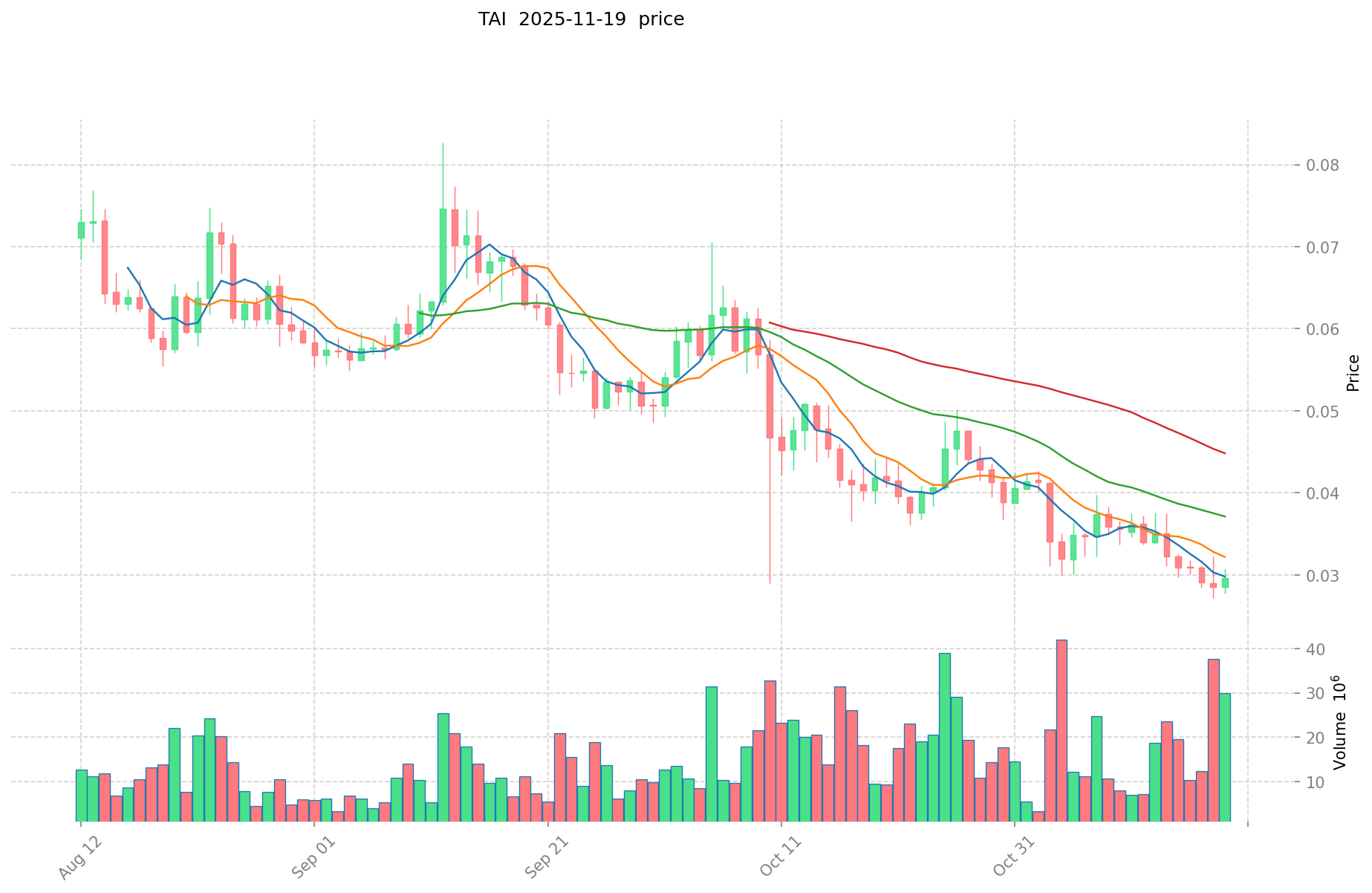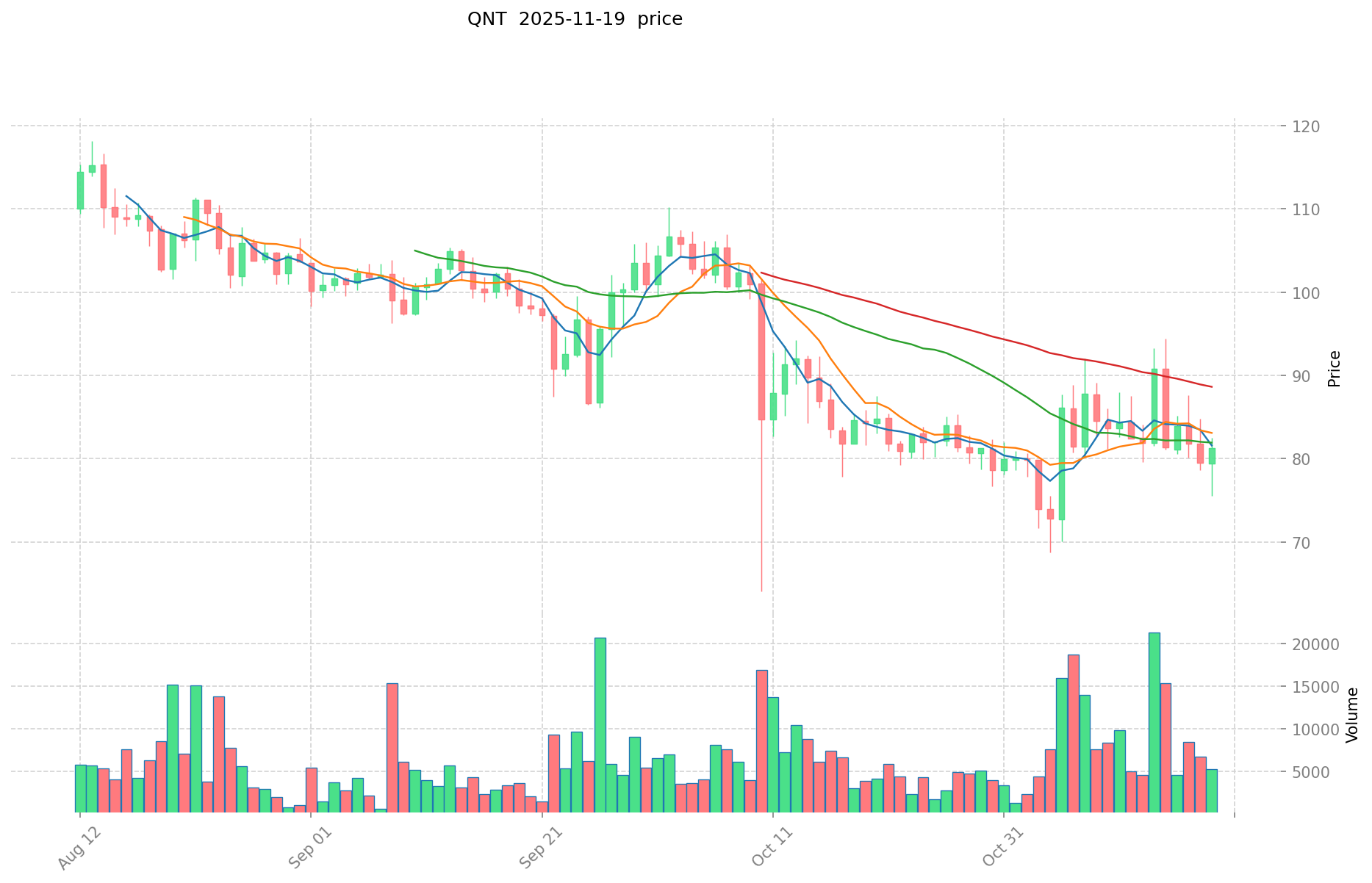TAI vs QNT: Comparing Two Promising Blockchain Protocols for Enterprise Adoption
Introduction: TAI vs QNT Investment Comparison
In the cryptocurrency market, the comparison between Tars AI (TAI) vs Quant (QNT) has been an unavoidable topic for investors. The two not only show significant differences in market cap ranking, application scenarios, and price performance, but also represent different positions in the crypto asset landscape.
Tars AI (TAI): Launched in 2024, it has gained market recognition for its AI-driven, scalable Web3 modular infrastructure platform.
Quant (QNT): Since its inception in 2018, it has been hailed as a technology provider enabling trusted digital interaction, recognized for solving interoperability through its global blockchain operating system, Overledger.
This article will comprehensively analyze the investment value comparison between TAI and QNT, focusing on historical price trends, supply mechanisms, institutional adoption, technological ecosystems, and future predictions, attempting to answer the question investors care about most:
"Which is the better buy right now?"
I. Price History Comparison and Current Market Status
TAI and QNT Historical Price Trends
- 2024: TAI reached its all-time high of $0.495 due to increased adoption.
- 2021: QNT hit its all-time high of $427.42 amid a broader crypto market rally.
- Comparative analysis: During the recent market cycle, TAI dropped from $0.495 to a low of $0.01, while QNT declined from $427.42 to around $75, showing more resilience.
Current Market Situation (2025-11-20)
- TAI current price: $0.02772
- QNT current price: $75.72
- 24-hour trading volume: TAI $536,633 vs QNT $196,745
- Market Sentiment Index (Fear & Greed Index): 15 (Extreme Fear)
Click to view real-time prices:
- Check TAI current price Market Price
- Check QNT current price Market Price


II. Core Factors Affecting TAI vs QNT Investment Value
Supply Mechanism Comparison (Tokenomics)
- TAI: Using technology to create value and build trust, focusing on sustainable investment markets beyond just returns
- QNT: Associated with high-performance blockchain technology with emphasis on core technical principles
- 📌 Historical Pattern: Supply mechanisms drive price cycle changes through technological innovation and market perception.
Institutional Adoption and Market Applications
- Institutional Holdings: Assessment requires analysis of market trends and project fundamentals
- Enterprise Adoption: Evaluation based on performance metrics comparing cross-border payment capabilities, settlement processes, and portfolio integration
- Regulatory Attitudes: Investment decisions should consider key factors such as liquidity, redemption restrictions, and accounting basis
Technology Development and Ecosystem Building
- Technology Innovation: Dr. Kuo Hong-da emphasizes using technology to create value and build trust in global investment markets
- Market Intelligence: Trading platforms provide various indicators of heat and credibility to evaluate potential value of project developments
- Ecosystem Comparison: Assessment should include comprehensive analysis of application scenarios and comparative performance with competing products
Macroeconomic Factors and Market Cycles
- Performance in Inflationary Environments: Requires analysis of underlying fundamentals rather than relying solely on investment reports
- Monetary Policy Effects: Investment value assessment should incorporate full understanding of specific conditions and comprehensive risk analysis
- Geopolitical Factors: Global investment infrastructure development impacts stability and sustainability of cross-border transactions
III. 2025-2030 Price Prediction: TAI vs QNT
Short-term Prediction (2025)
- TAI: Conservative $0.0250 - $0.0275 | Optimistic $0.0275 - $0.0394
- QNT: Conservative $52.83 - $75.47 | Optimistic $75.47 - $102.64
Mid-term Prediction (2027)
- TAI may enter a growth phase, with estimated prices ranging from $0.0220 to $0.0548
- QNT may enter a consolidation phase, with estimated prices ranging from $69.46 to $130.59
- Key drivers: Institutional capital inflow, ETF, ecosystem development
Long-term Prediction (2030)
- TAI: Base scenario $0.0313 - $0.0569 | Optimistic scenario $0.0569 - $0.0637
- QNT: Base scenario $67.45 - $132.26 | Optimistic scenario $132.26 - $162.68
Disclaimer
TAI:
| 年份 | 预测最高价 | 预测平均价格 | 预测最低价 | 涨跌幅 |
|---|---|---|---|---|
| 2025 | 0.0393822 | 0.02754 | 0.0250614 | 0 |
| 2026 | 0.046510929 | 0.0334611 | 0.028776546 | 20 |
| 2027 | 0.054780839865 | 0.0399860145 | 0.021992307975 | 44 |
| 2028 | 0.063019958152725 | 0.0473834271825 | 0.0265347192222 | 70 |
| 2029 | 0.058513794227669 | 0.055201692667612 | 0.052441608034231 | 99 |
| 2030 | 0.063680672661357 | 0.05685774344764 | 0.031271758896202 | 105 |
QNT:
| 年份 | 预测最高价 | 预测平均价格 | 预测最低价 | 涨跌幅 |
|---|---|---|---|---|
| 2025 | 102.6392 | 75.47 | 52.829 | 0 |
| 2026 | 96.178968 | 89.0546 | 73.024772 | 17 |
| 2027 | 130.58966544 | 92.616784 | 69.462588 | 22 |
| 2028 | 119.4154504504 | 111.60322472 | 104.9070312368 | 47 |
| 2029 | 149.007045484908 | 115.5093375852 | 102.803310450828 | 52 |
| 2030 | 162.67757558811642 | 132.258191535054 | 67.45167768287754 | 74 |
IV. Investment Strategy Comparison: TAI vs QNT
Long-term vs Short-term Investment Strategies
- TAI: Suitable for investors focused on AI-driven Web3 infrastructure and ecosystem potential
- QNT: Suitable for investors seeking interoperability solutions and established blockchain technology
Risk Management and Asset Allocation
- Conservative investors: TAI: 20% vs QNT: 80%
- Aggressive investors: TAI: 60% vs QNT: 40%
- Hedging tools: Stablecoin allocation, options, cross-currency portfolios
V. Potential Risk Comparison
Market Risk
- TAI: Higher volatility due to newer project status and AI market fluctuations
- QNT: Sensitivity to overall blockchain adoption and interoperability demand
Technical Risk
- TAI: Scalability, network stability, AI integration challenges
- QNT: Network congestion, potential security vulnerabilities in Overledger system
Regulatory Risk
- Global regulatory policies may impact both differently, with QNT potentially facing more scrutiny due to its longer market presence
VI. Conclusion: Which Is the Better Buy?
📌 Investment Value Summary:
- TAI advantages: AI-driven innovation, potential for rapid growth in emerging Web3 infrastructure
- QNT advantages: Established track record, focus on interoperability, broader institutional adoption
✅ Investment Advice:
- New investors: Consider a balanced approach, leaning towards QNT for its established presence
- Experienced investors: Explore a diversified portfolio including both TAI and QNT, adjusting based on risk tolerance
- Institutional investors: Conduct thorough due diligence on both, with potential focus on QNT for its enterprise solutions
⚠️ Risk Warning: The cryptocurrency market is highly volatile, and this article does not constitute investment advice. None
VII. FAQ
Q1: What are the main differences between TAI and QNT? A: TAI is a newer AI-driven Web3 infrastructure platform launched in 2024, while QNT is an established blockchain interoperability solution launched in 2018. TAI focuses on AI integration and scalable infrastructure, whereas QNT emphasizes cross-blockchain communication through its Overledger system.
Q2: Which cryptocurrency has shown better price stability? A: Based on historical data, QNT has demonstrated more price stability. During recent market cycles, QNT declined from $427.42 to around $75, while TAI dropped from $0.495 to $0.01, indicating QNT's greater resilience to market fluctuations.
Q3: What are the key factors affecting the investment value of TAI and QNT? A: Key factors include supply mechanisms, institutional adoption, technology development, ecosystem building, macroeconomic conditions, and market cycles. Additionally, regulatory attitudes and the projects' ability to innovate and adapt to market needs play crucial roles.
Q4: How do the long-term price predictions for TAI and QNT compare? A: For 2030, TAI's base scenario predicts a range of $0.0313 - $0.0569, with an optimistic scenario of $0.0569 - $0.0637. QNT's base scenario for 2030 is $67.45 - $132.26, with an optimistic scenario of $132.26 - $162.68. These predictions suggest potential growth for both, with QNT maintaining a higher absolute price.
Q5: What are the recommended investment strategies for TAI and QNT? A: For conservative investors, a portfolio allocation of 20% TAI and 80% QNT is suggested. Aggressive investors might consider 60% TAI and 40% QNT. It's advisable to use risk management tools such as stablecoin allocation, options, and cross-currency portfolios to hedge against market volatility.
Q6: What are the main risks associated with investing in TAI and QNT? A: Both face market risks due to cryptocurrency volatility. TAI has higher technical risks related to scalability and AI integration, while QNT faces potential challenges with network congestion and security. Regulatory risks apply to both, with QNT potentially facing more scrutiny due to its longer market presence.
Share
Content